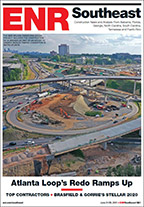Rail projects on the Northeast Corridor were the major winners as the U.S. Dept. of Transportation redistributed $2 billion in aid Florida turned down earlier this year.
The grants, announced on May 9, will fund about $1.7 billion in infrastructure. That will be good news for engineering and construction firms and ease the pain of Florida Gov. Rick Scott's move to cancel his state's rail plan.
The Northeast got about $1 billion, mostly for the Washington-to-Boston corridor. Peter Gertler, chairman of transit and high-speed rail services for HNTB, says about 75% of previous DOT rail awards went to California, Florida and the Midwest. Now, he says, “There has been a renewed interest in the Northeast.”
Transportation Secretary Ray LaHood says, “This is really our first opportunity to say to the Northeast Corridor, ‘We're willing to make investments to get to higher speeds.' ”
Amtrak, newly eligible for federal high-speed-rail funds, won the largest grant: $450 million for signal, track and catenary upgrades. Al Engel, Amtrak vice president for high-speed rail, says, “This does provide a down payment for really moving to true high-speed rail, next-generation high-speed rail.”
The grant is aimed at “the racetrack,” a 24-mile stretch from Morrisville, Pa., to New Brunswick, N.J. Speeds there are limited now to about 125 miles per hour. Engel says, “We need to go to a constant-tension catenary system, which is what we have north of New Haven to Boston, which will support 160-mph operation.” He says Amtrak will seek an outside firm for final design. Amtrak personnel will do most of the construction.
The Midwest fared well. Michigan won $199.3 million, mostly for track and signal upgrades from Kalamazoo to Dearborn. Illinois gets $186.3 million for improvements from Dwight to Joliet. California received $300 million for a 20-mile extension of a Central Valley line.
Funds won't be disbursed until states secure agreements with freight railroads, which own most of the track over which passenger service runs.



Post a comment to this article
Report Abusive Comment